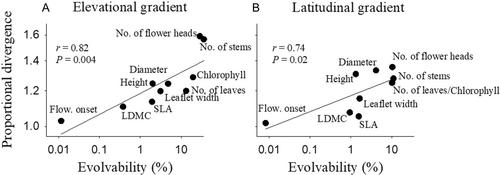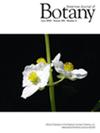Clinal variation in quantitative traits but not in evolutionary potential along elevational and latitudinal gradients in the widespread Anthyllis vulneraria
Abstract
Premise
Strong elevational and latitudinal gradients allow the study of genetic differentiation in response to similar environmental changes. However, it is uncertain whether the environmental changes along the two types of gradients result in similar genetically based changes in quantitative traits. Peripheral arctic and alpine populations are thought to have less evolutionary potential than more central populations do.
Methods
We studied quantitative traits of the widespread Anthyllis vulneraria in a common garden. Plants originated from 20 populations along a 2000-m elevational gradient from the lowlands to the elevational limit of the species in the Alps, and from 20 populations along a 2400-km latitudinal gradient from the center of the distribution of the species in Central Europe to its northern distributional margin.
Results
Most traits showed similar clinal variations with elevation and latitude of origin, and the magnitude of all measured traits in relation to mean annual temperature was similar. Higher QST values than FST values in several traits indicated diversifying selection, but for others QST was smaller than FST. Genetic diversity of quantitative traits and neutral molecular markers was not correlated. Plasticity in response to favorable conditions declined with elevation and less strongly with latitude of origin, but the evolvability of traits did not.
Conclusions
The clinal variation suggests adaptive differentiation of quantitative traits along the two gradients. The evolutionary potential of peripheral populations is not necessarily reduced, but lower plasticity may threaten their survival under rapidly changing climatic conditions.


 求助内容:
求助内容: 应助结果提醒方式:
应助结果提醒方式:


